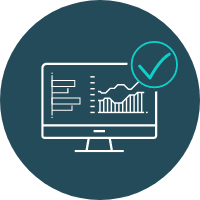
Predictive Analytics Examples
This guide provides diverse use cases and examples of predictive analytics, showcasing its transformative impact in different domains.
What is Predictive Analytics?
Predictive analytics utilizes statistical modeling, data mining methods, and machine learning to forecast future outcomes by analyzing historical and real-time data. These forecasts play a crucial role in helping you improve efficiency, mitigate risk, and identify opportunities.
Predictive Analytics Examples
Predictive analysis techniques find application across a diverse spectrum of industries and job roles. Below are eight real world examples of predictive analytics in various sectors.

Insurance.
Insurance providers can use predictive analytics to offer more tailored and competitive policies while ensuring the stability and profitability of their portfolios. This meticulous approach to risk assessment ultimately benefits both the insurer and the policyholder by fostering a more balanced and sustainable insurance environment. For instance, insurance companies utilize advanced analytical models to meticulously scrutinize policy applications. By evaluating the characteristics and profiles of policyholders with similar coverage, insurers can accurately estimate the likelihood of potential future claims. This process empowers them to make data-driven decisions regarding coverage terms, premiums, and risk management strategies.

Financial Services.
Predictive analytics is integral in shaping strategic choices, bolstering trust, and enhancing the stability and profitability of financial institutions. It anticipates loan default probabilities, ensuring a balanced lending portfolio by considering factors like credit history and market conditions. Additionally, it plays a crucial role in fraud detection, swiftly identifying and mitigating suspicious activities. In securities trading, it forecasts price movements by analyzing historical data and market trends. This empowers investors to make informed decisions, optimizing returns.

Retailers and CPG Companies.
Retailers and consumer packaged goods (CPG) companies leverage predictive analytics to enhance their marketing ROI, strengthen customer relationships, and maintain a competitive edge in this dynamic landscape. Retailers and CPG companies delve into the data of past promotional campaigns, using data visualization to examine their effectiveness. By scrutinizing factors like customer behavior, purchasing patterns, and response rates, they gain invaluable insights. These insights are then employed to forecast the success of future offers and promotions. This data-driven approach allows businesses to allocate resources efficiently, focusing on strategies that are statistically more likely to yield positive results.

Healthcare.
Healthcare companies harness the power of data analytics to delve into historical patient records and patterns. Predictive analytics enhances patient outcomes, reduces healthcare costs, and fosters a more efficient and responsive healthcare system. By analyzing factors like medical history, demographic information, and previous admission data, they develop sophisticated models to forecast patient admissions and readmissions. This proactive approach empowers healthcare providers to allocate resources efficiently, ensuring that the right level of care is available when needed. It also enables the implementation of targeted interventions and personalized care plans to mitigate factors that may lead to readmissions.

Energy and utilities.
Predictive analytics empowers energy and utilities companies to make informed, risk-reducing decisions, ultimately enhancing the reliability and safety of their operations. By analyzing historical equipment failures, companies preempt potential risks, enabling timely maintenance and replacement. This proactive approach minimizes accidents and creates a secure work environment. Additionally, predictive analytics forecasts future energy demands through an examination of past consumption patterns and consideration of various influencing factors. This allows for efficient resource allocation, guaranteeing a consistent energy supply.

Life Sciences.
Life sciences organizations provide some of the best predictive analytics examples, enhancing patient-centric care and optimizing treatment strategies. Organizations delve into patient data to create comprehensive personas, allowing for a deeper understanding of patient behaviors, preferences, and needs. By analyzing factors like demographics, medical history, and lifestyle, life sciences companies can tailor treatment plans to individual patient profiles, ultimately improving adherence rates. Moreover, predictive analytics enables the prediction of nonadherence to treatment plans. By considering various influencing factors such as patient history, socio-economic conditions, and treatment complexity, organizations can identify individuals who may be at higher risk of noncompliance. This proactive approach allows for targeted interventions, personalized support, and ultimately, improved patient outcomes.

Manufacturing and Supply Chain.
Predictive analytics empowers manufacturing and supply chain operations to operate with greater precision, ultimately improving customer satisfaction and reducing costs.is instrumental in revolutionizing manufacturing and supply chain operations. By delving into historical data and considering various variables like market trends, seasonality, and consumer behavior, companies can accurately forecast demand. This proactive approach enables them to optimize inventory management, ensuring that products are readily available to meet customer needs while minimizing excess stock. Additionally, predictive analytics plays a crucial role in identifying factors that may lead to production failures. By analyzing data related to machinery performance, environmental conditions, and maintenance schedules, companies can implement preventive measures to reduce downtime and enhance overall production efficiency.

The Public Sector.
Predictive analytics empowers the public sector to plan and implement infrastructure projects that align with the evolving needs and dynamics of the community, fostering sustainable growth and improving quality of life. By scrutinizing extensive datasets on population demographics, growth patterns, and urban migration, government entities gain crucial insights. These insights are then leveraged to make informed decisions regarding infrastructure investments and various public works projects. For instance, predicting population shifts allows for strategic allocation of resources towards the construction of housing, transportation networks, and essential amenities. Moreover, anticipating future demands for services like healthcare, education, and utilities ensures that public resources are utilized efficiently and effectively.
How Predictive Analytics Works
The specific approach you adopt will hinge on your data types and the particulars of your specific scenarios. Still, here's a general outline of the process.

1) Establish a clear objective. Begin by articulating the business question you aim to address or the problem you intend to resolve. In essence, what is it that you seek to predict? This clarity regarding the project's ultimate goal will shape your data needs and enable your predictive model to produce a practical outcome.
2) Build the right team. While new AI analytics tools make it much easier, you should still consider having the following key players on your team: an executive sponsor, a line-of-business manager, a data wrangler or someone with data management expertise, an IT manager, and a data scientist to build, refine and deploy the models (although AutoML tools now allow data analysts to do this).
3) Collect and integrate your data. This involves assembling the necessary information and organizing your dataset. Conduct data discovery and data exploration to include all relevant factors to ensure a comprehensive perspective and enhance the accuracy of your model. This may encompass well-structured data like sales records and demographic details, as well as unstructured data such as social media posts, customer service records, and web logs.
4) Develop and validate your model. This phase involves constructing, training, assessing, and implementing your predictive model. You have two options: either enlist a data scientist to develop a model, or utilize modern AutoML (automated machine learning) tools, simplifying the process of creating, training, and deploying customized ML models on your own. Furthermore, there are two primary types of algorithmic models: classification and regression, both of which will be elaborated on in the following section. These algorithms ultimately assign a numerical value, weight, or score to indicate the likelihood of a specific event occurring in the future. It will be necessary to test and fine-tune your model iteratively to identify the most proficient performer—one that generates predictions aligning with your expectations.
5) Deploy your model. Ultimately, you'll apply your model to the selected dataset. The outcomes can inform either single-instance or continuous decision-making, and you also have the option to automate actions by incorporating the output into other systems. It's ideal for your model to adapt automatically as fresh data is incorporated over time; this dynamic adjustment enhances the precision of predictions.
6) Monitor and refine your model. Monitor your model's outputs to ensure they align with your anticipated results. Employing explainable AI techniques and processes will help you understand the rationale behind the output of your model. As new variables come into play, be prepared to make necessary adjustments to the model. Additionally, enhancing your model's predictive capabilities can be achieved through the application of data mining techniques like clustering, sampling, and utilizing decision trees on accumulated data over time.
Predictive Analytics Use Cases
Predictive analytics finds versatile applications across various industries, revolutionizing decision-making processes. From enhancing customer experiences to optimizing operational efficiency, it plays a pivotal role in areas such as inventory management, fraud detection, healthcare diagnosis, and more. Here, we'll explore twelve diverse use cases, showcasing its transformative impact in different domains.
-
1. Fraud detection employs advanced algorithms to scrutinize financial transactions for patterns and anomalies. By analyzing historical data and user behavior metrics, it quickly spots suspicious activities. This allows for timely intervention and prevention of fraudulent transactions, ensuring the security of financial institutions and their customers.
-
2. Forecasting and predicting buying behavior involves analyzing customer data, including past purchases, browsing habits, and demographic information. Advanced algorithms forecast future purchasing trends, enabling your business to tailor marketing strategies, optimize product offerings, and enhance customer experiences for increased sales and customer satisfaction.
-
3. Equipment maintenance employing predictive models anticipates potential malfunctions or breakdowns. By analyzing historical performance data and usage patterns, your business can schedule maintenance activities proactively. This approach ensures optimal equipment functionality, minimizes unexpected downtimes, and extends the lifespan of your critical assets.
-
4. Healthcare diagnosis benefits from predictive models that analyze patient information, symptoms, and medical history to aid in accurate diagnoses. By leveraging advanced algorithms, this approach enhances clinical decision-making, improves treatment plans, and ultimately leads to better patient outcomes.
-
5. Risk modeling entails analyzing historical and real-time data to assess and forecast potential risks in various scenarios. By identifying potential threats and their probabilities, your business can implement proactive measures to mitigate risks, enhance decision-making, and safeguard against adverse events.
-
6. Customer segmentation employs data analysis to categorize customers based on shared characteristics, behaviors, and preferences. This allows businesses to tailor marketing strategies, product offerings, and communication methods to specific customer groups. The result is more targeted and effective marketing campaigns, leading to higher customer satisfaction and retention rates.
-

7. Quality assurance employs data-driven models to forecast potential defects or issues in manufacturing processes. By analyzing historical data and key parameters, it helps preemptively identify areas for improvement, enhancing product quality, reducing defects, and ensuring customer satisfaction.
-
8. Up-Selling and Cross-Selling involves analyzing customer behavior, preferences, and purchase history. Advanced algorithms identify opportunities to recommend complementary or higher-value products. This strategy maximizes revenue, enhances customer satisfaction, and fosters long-term loyalty.
-

9. Inventory management uses data analysis to anticipate demand trends. By considering factors like historical sales, seasonal trends, and market fluctuations, businesses optimize stock levels. This ensures products are available when needed, minimizing excess inventory and reducing carrying costs.
-
10. Content recommendations are driven by algorithms that analyze user behavior, preferences, and interactions with online content. By processing this data, personalized suggestions are generated, enhancing user engagement, satisfaction, and driving overall content consumption.
-

11. Virtual assistants better anticipate user needs and provide contextually relevant responses based on machine learning vs AI algorithms that analyze user inquiries and behaviors. This enhances the efficiency and effectiveness of virtual assistants, creating more seamless and personalized user interactions.
-

12. Reducing churn involves analyzing customer data and behavior to predict which customers are at risk of leaving. By identifying early signs of dissatisfaction or disengagement, businesses can implement targeted retention strategies. This proactive approach aims to improve customer satisfaction and ultimately reduce customer turnover.
Frequently Asked Questions
What are the four types of analytics?
As shown below, descriptive and diagnostic analytics describe the present situation whereas predictive and prescriptive analytics involve data science to forecast the future and make specific recommendations on your optimal course of action.
| Type | Question Answered |
|---|---|
|
What happened?
|
|
|
Diagnostic
|
Why did it happen?
|
|
Predictive
|
What will happen?
|
|
What should we do?
|
What are the benefits of predictive analytics?
Predictive data analytics uses artificial intelligence and big data to help you make better, data-driven decisions towards increasing revenue, improving operational efficiencies, and reducing fraud. It also reduces the risk of human bias or error because your decisions are driven by data, not instinct.
What are the main types of predictive models?
The main types of predictive analytics models are regression models and classification models. Regression models predict numerical values, while classification models assign data points to predefined categories. Decision trees and neural networks can be used as classification models. Decision trees classify data points by following a series of if-else conditions, while neural networks use complex mathematical functions to classify data based on patterns learned from training data.

